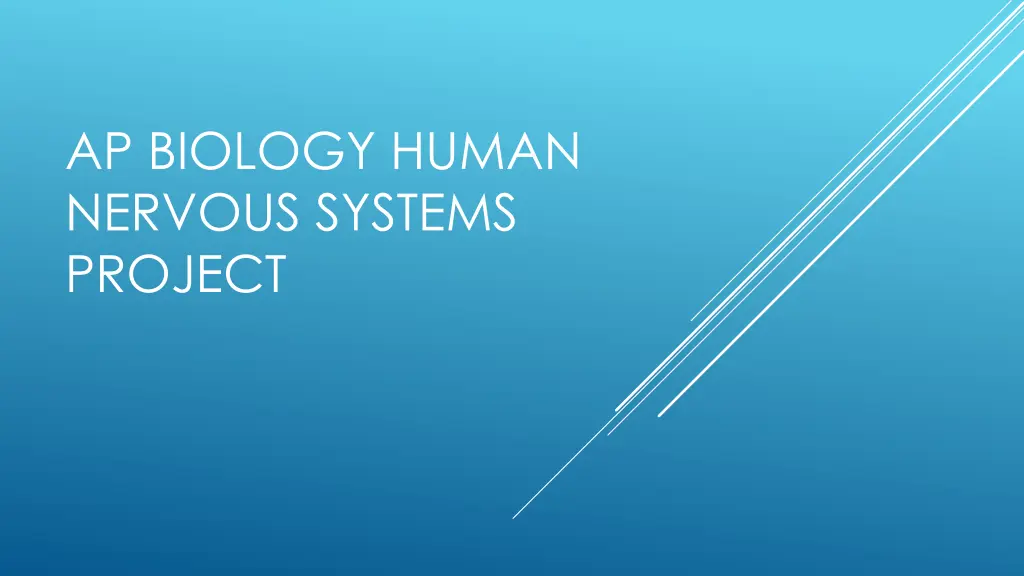
Understanding the Human Nervous System in AP Biology
The human nervous system is a complex network of neurons and axons that controls bodily functions through nerve signals. It consists of the central and peripheral nervous systems, with key components like the brain, spinal cord, and various types of nerves. Explore how neurons interact, reflex arcs function, and different brain regions contribute to sensory perception and motor control.
Download Presentation

Please find below an Image/Link to download the presentation.
The content on the website is provided AS IS for your information and personal use only. It may not be sold, licensed, or shared on other websites without obtaining consent from the author. If you encounter any issues during the download, it is possible that the publisher has removed the file from their server.
You are allowed to download the files provided on this website for personal or commercial use, subject to the condition that they are used lawfully. All files are the property of their respective owners.
The content on the website is provided AS IS for your information and personal use only. It may not be sold, licensed, or shared on other websites without obtaining consent from the author.
E N D
Presentation Transcript
AP BIOLOGY HUMAN NERVOUS SYSTEMS PROJECT
The function of the nervous system is to control and alert the body. It directs actions and alerts through various nerve signals it sends to cells throughout the body. There are 2 types of these cells neurons and axons. FUNCTION
Central Nervous System-the complex of nerve tissues that controls the activities of the body. The major parts are the brain and spinal cord. Neurons send the messages Peripheral Nervous System-The portion of the nervous system that is outside the brain and spinal cord. The major parts include the 12 cranial nerves, the spinal nerve roots, and the autonomic nerves. Nerves send the messages. DEFINITIONS
Dendrites Cell Body Synapse Nucleus Axon INTERACTION OF 2 NEURONS
Receptor Grey Matter Interneuron Sensory Neuron Motor Nerve Fiber White Matter Transverse Section through spine Muscle The route followed by nerve impulses in the production of a reflex act, from the peripheral receptor organ through the afferent nerve to the central nervous system synapse and then through the efferent nerve to the effector organ. It connects peripheral and central nervous systems. REFLEX ARC
Left Cerebral Hemisphere Right Cerebral Hemisphere Pineal Glands Mid-Brain Cerebrum Thalamus Pituitary Gland Pons Medulla Oblongata Spinal Cord Cerebellum Functions of Various Parts Cerebral Hemispheres- Language, Movement, Senses, and visual processing Diencephalon- Sensing, touch perception, homeostasis, motor function control, endocrine control, and autonomic control. Brain Stem-Alertness, Arousal, Breathing, Blood Pressure, Digestion, Heart Rate, and autonomic functions. (Relays Information Cerebellum-Fine Movement Coordination, balance and equilibrium, and muscle tone. THE BRAIN
Dendrites Cell Body Synapse Nucleus Axon Resting Potential Resting Potential- outside of nerve cell has high concentration of Na+ and low concentration of K+ and inside has opposite. Action Potential has the same only the concentration of Na+ is increased inside of nerve cell. Threshold is the level at which depolarization is complete and action potential can happen The refractory period happens after Repolarization in which the nerve can regain resting potential NERVE IMPULSE
Neurotransmitters signal messages throughout the body by passing through neurons. They change the permeability of ions in neurons and the potential of the membrane. IPSP- net gain of negative charge when the ion burrow is opened, brings the potential up from it's resting potential (usually -70mV), resulting in the neuron going further away from the firing potential, making it less credible to trigger, hence the word 'inhibitory'. EPSP- net gain of positive charge when the ion depression is opened, brings the potential of a neuron down from it's resting potential (usually -70mV) closer to it's firing potential (-50mV).
Depression is a emotional disorder that involves mood, thoughts, and the body. It effects a person s perception of themselves and how one eats or sleeps. Signs and symptoms depend on which subtype and severity - Sadness - Inappropriate crying - Feelings of Worthlessness Prevalence-The leading cause of disability in the U.S. for ages 15 to 44.3 Affects approximately 14.8 million American adults, or about 6.7 percent of the U.S. population age 18 and older in a given year. While major depressive disorder can develop at any age, the median age at onset is 32.5 More prevalent in women than in men Treatment options -Psychotherapy -Mood Stabalizers DEPRESSION
A disorder of movement, muscle tone or posture that is caused by an insult to the immature, developing brain, most often before birth. Signs and Symptoms - Variations in muscle tone, such as being either too stiff or too floppy - Stiff muscles and exaggerated reflexes (spasticity) - Stiff muscles with normal reflexes (rigidity) - Lack of muscle coordination (ataxia) - Tremors or involuntary movements - Slow, writhing movements (athetosis) - Delays in reaching motor skills milestones, such as pushing up on arms, sitting up alone or crawling - Favoring one side of the body, such as reaching with only one hand or dragging a leg while crawling - Difficulty walking, such as walking on toes, a crouched gait, a scissors-like gait with knees crossing or a wide gait - Excessive drooling or problems with swallowing Prevalence Population-based studies from around the world report prevalence estimates of CP ranging from 1.5 to more than 4 per 1,000 live births or children of a defined age range Treatment -Medical Care Team - Generalized spasticity - Therapy - Surgery CEREBRAL PALSY
http://biology.about.com/od/anatomy/p/diencephalon.htm http://www.livestrong.com/article/142538-cerebral-hemisphere-functions/ http://www.medilexicon.com/medicaldictionary.php?t=5931 http://biology.about.com/od/anatomy/p/Brainstem.htm http://www.medicinefreefaq.com/medicine/medicine-2-1378.html http://www.rightdiagnosis.com/d/depressive_disorders/prognosis.htm http://www.rightdiagnosis.com/d/depressive_disorders/intro.htm http://www.adaa.org/about-adaa/press-room/facts-statistics http://www.mayoclinic.org/diseases-conditions/cerebral- palsy/basics/treatment/con-20030502 http://www.cdc.gov/ncbddd/cp/data.html
